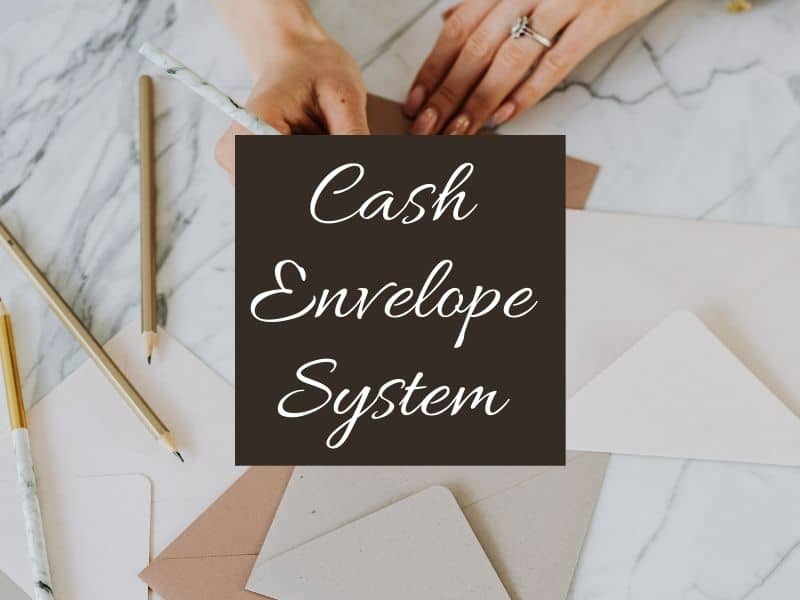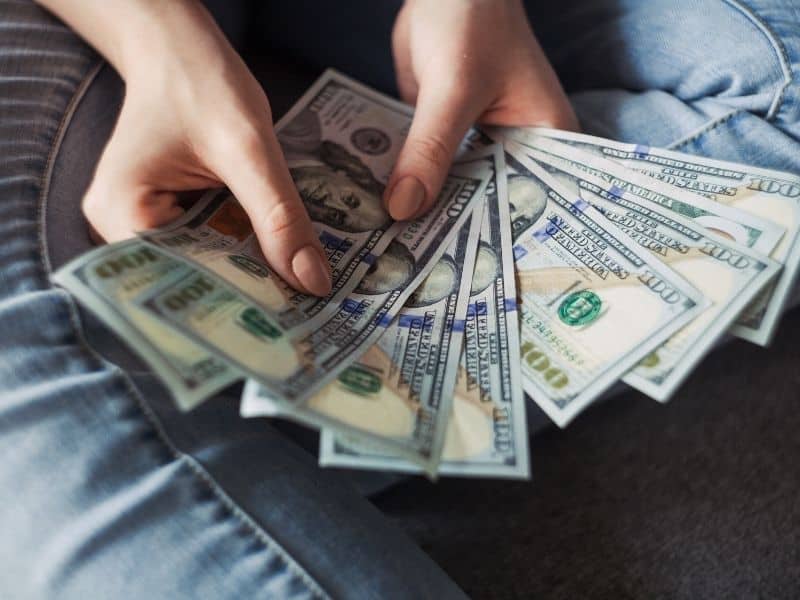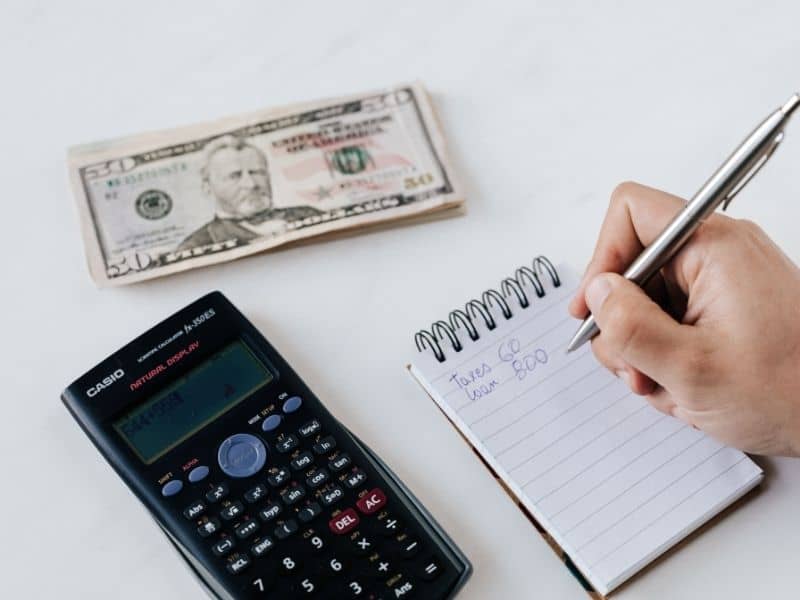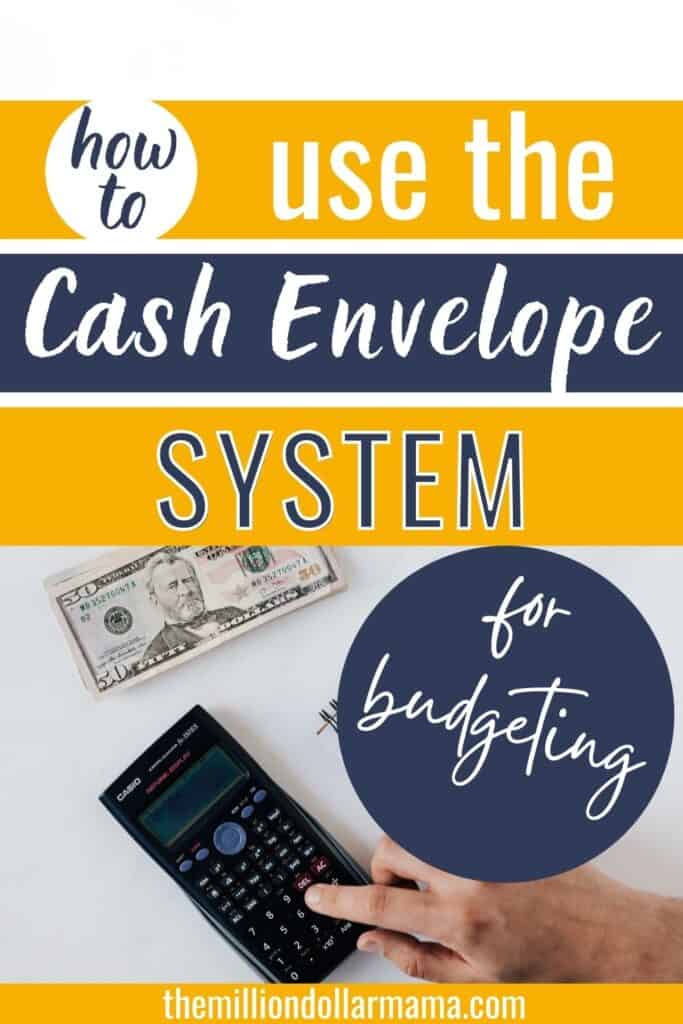Learn how to use the cash envelope system to establish budgets and track your spending. Take control of your finances with this easy (and fun) way of tracking your expenses!

The cash envelope system was originally developed by Dave Ramsey and is such an awesome way to keep track of your budget if that’s something you struggle with.
You may also want to start learning about budgeting with these books about budgeting (choose one or read them all!) and reading the key to budget cutting.
What Is The Cash Envelope System?
The cash envelope system is a way to track exactly how much money you spend in each budget category. You do this by establishing budget categories and putting cash money into envelopes every month or every payday.
If you get paid weekly or bi-weekly, use paycheck budgeting to make sure you’re never broke!
Related: Example of a Cash Budget
Why Use A Cash Envelope System?
With physical cash it’s much easier to see where your money is going because there’s no ambiguity. It’s totally black and white.
If you never see that cash money and you’re always doing electronic transfers to pay this bill or swiping a credit card to buy that thing, money loses its importance. When you can see and feel your cash, it becomes much more real.
Think about it. How much more difficult is it to fork over $100 cash for those cute boots than to simply swipe that card?
If you’re like me, I really THINK about what I’m spending way more when I physically turn over the cash at the register vs. swiping the card! Digital money just seems to be less real because it’s not tangible.

Does The Cash Envelope System Work?
Yes, many people have had great success using the envelope system. It’s pretty much a proven fact that you will spend less if you use cash versus using a credit card because it hurts more to make purchases with cash vs a card.
The cash envelope system is especially effective for people that are impulse spenders and those that are new to budgeting. If you’re an impulse spender, the envelope system will help you because you will be planning almost all of your variable purchases based on the amount of cash in the envelopes.
This system leaves very little room for impulse purchases. It also forces you to organize your monthly bills.
And if you’re a new budgeter, the cash envelope system is a great way to kick-start your budgeting and move closer to your money goals. It’s kind of like a fast for money!
If you only have $60 left in your “Food” envelope and not much in the fridge, then you will recognize that you better forego ordering takeout in lieu of a grocery store run!
Similarly, if you only have $50 left in your “Fun” envelope, you’ll have to decide whether you want to go bowling OR meet up for happy hour on Friday!
Plus, it’s a great way to get started working the steps for Dave Ramsey’s 7 baby steps.
What Do I Need To Start The Cash Envelope System?
The best way to start with the system is to look at your budget and make envelopes for each of your variable spending categories. For the cash envelope system to work effectively you have to know where your money goes!
Doing a no spend challenge first is a great way to find where you can reduce expenses and will help you create a budget.

What If I Don’t Have A Budget?
Don’t worry if you don’t have a budget! A budget doesn’t have to be complicated. Grab a piece of paper and write down two columns.
Title one column “Income”. Title the other column “Expenses”. Under “Income”, write down the money you make every month. For “Expenses”, write down all your bills. That’s it. That’s your budget.
If you want to put a little more thought into your budget, I have a free printable in this total budget makeover post. You may also want to try using a bullet journal for budgeting.
What Kind Of Expenses Should I Use The Cash Envelope System For?
One thing to keep in mind is that the cash envelope system works best for your variable spending. These are the things that aren’t fixed expenses each month like your mortgage and your car payment.
Variable expenses are just that: variable. These are your expenses that fluctuate each month. Think of things like groceries, dinners out and pet care.
Learn more about these personal budget categories.
Variable expenses benefit from the envelope system because you’re more likely to overspend on them. You really can’t overspend on your mortgage.
**However, you can try to reduce your fixed expenses by doing things like reducing your utility bills.
But those Amazon swipes add up and before you know it, you busted your budget! You get your Visa bill and you’ve spent over $300 dollars on things you never knew you needed!
With the envelope system, that won’t happen! Once the money in the envelope is gone, it’s gone. No more spending in that category until you add more money to the envelope on your next payday or at the beginning of the next month, whatever you choose as your timeframe to reload your envelopes.
You can add to the envelope monthly or do like I do and reload every time I get paid, which is twice a month.
The key thing to remember is that when the cash has been spent from that envelope, there’s NO more spending in that category until you add more on your next payday or the next month.
What Cash Envelopes Should I Have?
What categories you have in your budget is totally up to you and every person’s envelopes will be different. It’s all based on your lifestyle.
For instance, I don’t have little kids so I don’t have an envelope marked “kids’ stuff”. I do have an envelope marked “home improvement” because we like to make improvement to our home. My other envelopes are: Gardening, Food/Restaurants, Clothes, Beauty, Gas, Amazon/Impulse, and Hobby just as a few examples.
How To Implement The Cash Envelope System
- Get your paycheck
- Subtract your fixed bills
- Withdraw the remaining balance of your paycheck in cash from your bank
- Make specific envelopes for each category
- Put the cash into each specific envelope
- Spend the cash in the envelope only for items in that specific category
- When the cash in that envelope is gone, no more spending in that category until the cash is replenished into the envelope at next pay day
Example Of Envelope Set Up
Here is an example of the cash envelope system based on a take home income of $3000 per month.
- Paycheck: $3000 per month
- Subtract out fixed bills. Fixed bills would look like this: Savings $500, Rent $800, Car $250, Utilities $200, Phone $100, Insurance $150. Total Fixed Bills Are $2000. This leaves $1000 to be used towards variable expenses
- Go to the bank and withdraw $1000 in cash
- Make specific envelopes for each variable spending category. Your envelopes could be something like this: Food/Restaurants $500, Gas $100, Hobby $100, Clothes $50, Fun Money $150, Impulse Spending $100. These are just examples. Make your own envelope categories!
- Put specific amount of cash budgeted for each category into each envelope. So you’d have an envelope for food/restaurants that you’d put $500 into. You’d have a gas envelope that you’d put $100 into, a hobby envelope that you’d put $100 into; and so on.
What About Things I Buy Online And Pay For With My Credit Card?
Everyone buys things online these days. It would be virtually impossible to pay cash for everything I use in my life.
I regularly shop on Amazon like I’m sure some of you do also. And, I’m not sure it’s even possible to shop on Amazon without using a credit card. I’d venture to say that nearly everyone does some sort of online buying where a credit card is essential.
The good news is that with the cash envelope system, you can still use your credit card for your online purchases. Just write that purchase down on the envelope with the purchase date. Then take the cash out of the envelope and put it into a file to save until you pay the credit card bill that month.
For instance, I just bought a book on Amazon for $20. I jotted down the purchase and date on the front of the impulse/Amazon envelope and took out $40 cash.
I put the $40 into a separate file that I labeled “Credit Card”. When I go to pay my credit card, I’ll put that $40 back in the bank, and use it to pay my credit card bill. I’ll do this same process for each online purchase I make with a credit card.
Adjust Your Envelopes as Needed
Once you create your original envelopes, they aren’t set in stone. You can definitely make adjustments to your envelopes. If you find that you never spend any money from a certain envelope, then you probably don’t need that envelope.
If you find you are spending way less in your food category than in your Amazon category, adjust the amount budgeted to those envelopes in the next month.
What Should I Do with Cash Leftover in Envelopes?
If you have money left over each month, that’s fantastic! You can take any leftover cash and use it to pay off any debt you have, invest your money, or you can stash that extra cash into your savings! Learn the difference between being rich vs. wealthy – it will change your outlook completely!
What Envelopes to Use
You can use just simple white letter envelopes, or try some of these fun ones:
- Plastic binder envelopes (they can be kept in a binder if you’re one of those super organized people)
- I love these beautiful laminated envelopes
- Cash envelope planner
- Reusable plastic envelopes
In Conclusion
If you want to get a better handle on your spending, give the cash envelope system a try. It may take a little work initially, but after you get used to the system, chances are you’ll find yourself looking forward to tracking your cash expenses and saving money each month!
Hi I’m Ana. I’m all about trying to live the best life you can. This blog is all about working to become physically healthy, mentally healthy and financially free! There lots of DIY tips, personal finance tips and just general tips on how to live the best life.


Leave a Reply